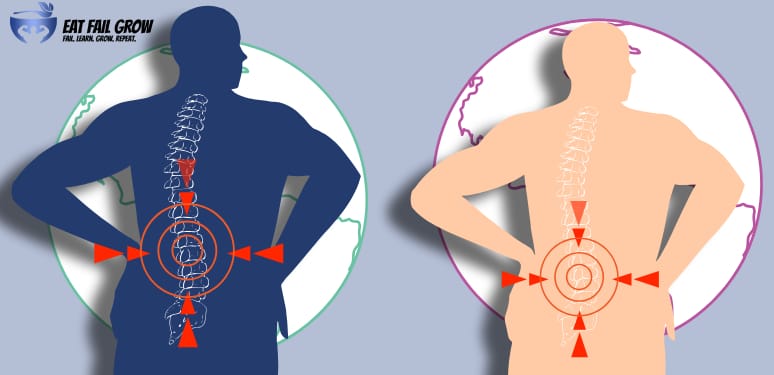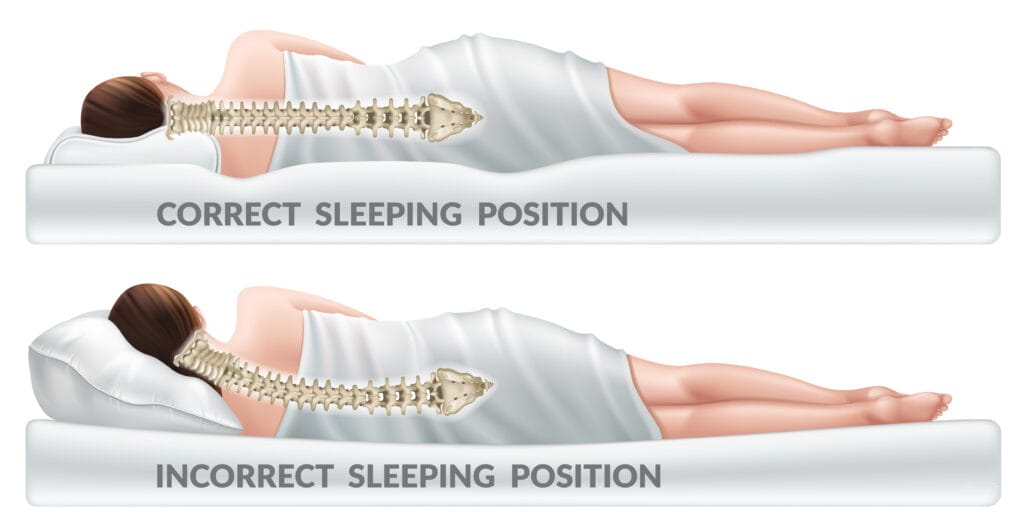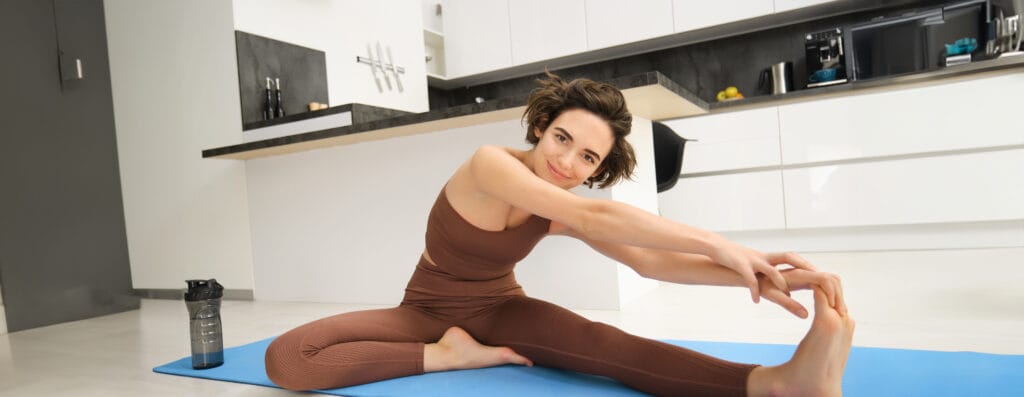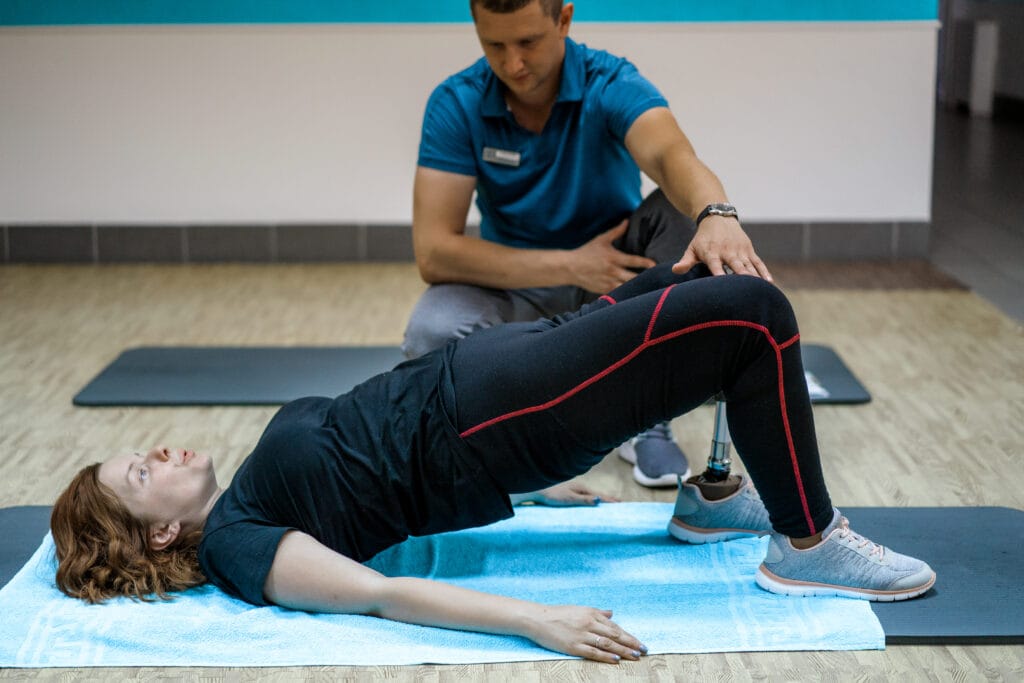
Finding the best sleeping position for sciatica can transform restless nights into restorative sleep. This comprehensive guide explores evidence-based sleeping positions and strategies to help alleviate sciatic pain, with practical solutions for fitness enthusiasts and anyone seeking relief from this debilitating condition.
Understanding Sciatica and Its Impact on Sleep
✅ What is Sciatica?
- A condition where pain radiates along the sciatic nerve, which runs from the lower back through the buttocks and legs.
- Often caused by nerve compression from herniated discs, spinal stenosis, or piriformis syndrome.
- Symptoms include sharp pain, tingling, numbness, and muscle weakness.
✅ Why Does Sciatica Affect Sleep?
- The sciatic nerve is the longest and largest in the body, making it highly sensitive to pressure.
- Pain often worsens at night due to prolonged inactivity and certain sleeping positions.
- Discomfort can lead to frequent sleep disturbances and difficulty finding relief.
✅ Impact on Fitness & Recovery
Choosing the best sleeping position for sciatica can help reduce pain and improve muscle recovery.
Poor sleep worsens sciatic pain, making recovery slower for athletes and fitness enthusiasts.
Lack of quality rest can affect training performance and overall well-being.
Comparing Effective Sleeping Positions for Sciatica Relief
Finding the right sleeping position can significantly reduce sciatic pain and improve your quality of sleep. According to research from the American Academy of Sleep Medicine, proper sleep positioning not only alleviates pressure on the sciatic nerve but also promotes better overall sleep quality. Below, we’ve outlined the three most effective sleeping positions for managing sciatica pain.
| Sleeping Position | Benefits | Best For | Implementation |
| Back Sleeping with Elevated Knees | • Maintains natural spine alignment • Distributes weight evenly • Reduces pressure on sciatic nerve • Decreases lumbar lordosis | • General sciatica relief • Herniated disc issues • Post-workout recovery | Place pillows under knees to create 30-45° bend |
| Side Sleeping with Pillow Between Knees | • Prevents pelvic rotation • Maintains hip alignment • Reduces pressure on affected side | • Piriformis syndrome • Pregnancy-related sciatica • Hip pain with sciatica | Position affected side up with supportive pillow between knees |
| Fetal Position | • Creates space between vertebrae • Reduces disc pressure • Opens intervertebral foramen | • Herniated disc sciatica • Acute flare-ups • Pinched nerve relief | Curl knees toward chest with painful side facing up |

Back Sleeping with Elevated Knees: The Gold Standard
Sleeping on your back with elevated knees is a game changer for sciatica and lower back pain. This position maintains natural spine alignment and evenly distributes body weight, preventing excessive pressure on any one part of the spine.
Quick Tips for Optimal Comfort:
- Lie flat on a medium-firm mattress 🛏️
- Place pillows under your knees to create a slight bend 🛋️
- This simple adjustment reduces the lumbar spine’s natural arch, easing pressure on discs.
To take it up a notch, use a wedge cushion system to elevate both the upper body and legs 🔝. This helps reduce spinal compression and promotes better recovery.
Fitness lovers 🏋️♂️ will benefit as this position allows muscles to fully relax, keeping the spine aligned for faster recovery and less inflammation around the sciatic nerve.
Side Sleeping with a Pillow Between the Knees: Strategic Support
Side sleeping can help relieve sciatica pain by reducing pressure on the sciatic nerve. Placing the affected leg on top is key to minimizing strain and ensuring comfort. 🌙
How to Optimize Side Sleeping:
- Pillow Between the Knees 🛏️: Keeps your spine, hips, and pelvis aligned.
- Contoured Knee Pillow 🛋️: Offers better support for the knee and enhances comfort.
- Waist Support 💪: A small pillow between your waist and the mattress helps maintain your spine’s natural curve.
This position is especially beneficial for fitness enthusiasts 💪 dealing with muscle tightness from running 👟, cycling 🚴, or strength training 🏋️♂️. It supports muscle relaxation and helps maintain proper alignment for better recovery.
Pre-Sleep Stretches for Sciatica Relief
| Stretch | Primary Target | How to Perform | Duration | Benefits |
| Knee-to-Chest | Lower back and glutes | Lie on back, pull one knee toward chest | Hold 30 seconds each side | Relieves tension in piriformis and lower back |
| Seated Figure-Four | Piriformis and hip rotators | Sit with ankle on opposite knee, lean forward | Hold 30-60 seconds each side | Releases compression on sciatic nerve |
| Cat-Cow | Entire spine | On hands and knees, alternate arching and rounding back | 10 repetitions | Improves spinal mobility and relieves pressure |
| Gentle Twist | Obliques and spinal rotators | Lie on back, knees bent, rotate legs to side | Hold 30 seconds each side | Releases tension in back muscles |
| Child’s Pose | Lower back and hips | Kneel with arms extended, sit back on heels | Hold 60 seconds | Gentle stretch and relaxation for entire back |

Optimizing Your Sleep Environment: Beyond Position
Mattress Selection for Sciatica Relief
The foundation of any effective sleeping position begins with the right mattress. Most experts recommend a medium-firm mattress for individuals with sciatica and lower back pain, providing sufficient support to maintain proper spinal alignment without creating uncomfortable pressure points.
Mattress Firmness Comparison for Sciatica Relief:
| Firmness Level | Benefits | Drawbacks | Recommended For |
| Soft (1-3/10) | Cushions pressure points | Allows excessive sinking, misaligns spine | Not recommended for sciatica |
| Medium-Soft (4/10) | Balance of comfort and minimal support | May not provide enough support for proper alignment | Side sleepers with minimal sciatica |
| Medium (5/10) | Good balance for average weight individuals | May not be ideal for very light or heavy individuals | General sciatica relief, combination sleepers |
| Medium-Firm (6-7/10) | Provides optimal support while allowing some contouring | May feel too firm initially | Most sciatica sufferers, especially back sleepers |
| Firm (8-10/10) | Maximum support for spine alignment | Can create pressure points for some sleepers | Severe sciatica from spinal misalignment, heavier individuals |
Research suggests that sleeping on a medium-firm mattress can significantly reduce the incidence of lower back pain and sciatica compared to very soft or very firm alternatives. The optimal medium-firm surface provides consistent support across the entire body while still allowing slight contouring around the shoulders and hips.
For individuals who incorporate heavy resistance training in their fitness regimen, proper mattress support becomes even more critical to facilitate nocturnal recovery and prevent exacerbation of sciatic symptoms from muscle fatigue and soreness.
Strategic Pillow Selection and Placement
Beyond a good head pillow, strategic pillow placement can improve spinal alignment and reduce discomfort:
✔ Side Sleepers: Use a knee pillow to keep hips aligned and reduce lower back strain.
✔ Back Sleepers: Place a pillow under the knees to ease lumbar pressure.
✔ Extra Support: Position pillows to prevent rolling into painful positions during sleep.
Using pillows effectively enhances comfort and maximizes sciatica relief.
Pre-Sleep Routines for Managing Sciatica
Establishing an effective bedtime routine can ease nerve irritation and muscle tension, improving sleep quality—especially for fitness enthusiasts who rely on rest for recovery and performance.
1. Gentle Stretching and Mobility Work
Performing light stretches 15-30 minutes before sleep can:
✔ Relax muscles around the sciatic nerve
✔ Improve blood circulation to tight areas
✔ Reduce tension that may worsen symptoms overnight
For active individuals, this helps counteract the stress of intense workouts and enhances muscle recovery.
2. Heat Application
Applying heat before bed can loosen tight muscles and improve circulation:
- Warm shower or bath (30 minutes before bed): Provides full-body relaxation.
- Heating pad (15-20 minutes on lower back & buttocks): Targets specific areas of tension, reducing inflammation and pain.
3. Creating an Optimal Sleep Environment
A well-prepared sleep setting can enhance rest and pain relief:
✅ Temperature: Keep your room between 65-68°F (18-20°C) to prevent muscle stiffness.
✅ Noise & Light Control: Use blackout curtains or a white noise machine to minimize disruptions.
✅ Consistent Sleep Schedule: Sleeping and waking at the same time daily—even on weekends—helps regulate your body’s recovery cycles, crucial for athletes and fitness enthusiasts.
Positions to Avoid with Sciatica: Stomach Sleeping
Stomach sleeping is the least advisable position for individuals with sciatica due to multiple alignment issues that can worsen nerve compression and pain. Here’s why:
✅ Spinal Misalignment: This position flattens the natural lumbar curve and forces the neck to rotate, leading to poor spinal alignment.
✅ Increased Nerve Pressure: The midsection, being the heaviest part of the body, sinks into the mattress, causing excessive lumbar extension. This can narrow nerve pathways, increasing pressure on the sciatic nerve.
✅ Delayed Recovery: For fitness enthusiasts, this sleeping posture adds unnecessary stress to the spine, hindering recovery and affecting overall performance.
Better Alternative? Opt for side or back sleeping with proper support to maintain spinal neutrality and reduce nerve irritation.
Integrating Sciatica Management with Fitness Goals
For active individuals, finding the best sleeping position for lower back pain and sciatica extends beyond nighttime positions to include modifications in training and daily activities. Consider these strategies to complement your sleep positioning:
Daily Pain Management Strategies for Active Individuals with Sciatica:
| Time of Day | Activity | Benefit for Sciatica | Exercise Modification |
| Morning | Dynamic stretching routine | Prepares muscles and nerves for daily activity | Focus on gentle movement without strain |
| Pre-Workout | Targeted warm-up and mobility work | Increases blood flow to affected areas | Extend warm-up time by 5-10 minutes |
| During Workout | Modified exercise selection | Avoids positions that aggravate sciatica | Substitute exercises that cause pain |
| Post-Workout | Specific cool-down stretches | Prevents muscle tightness that could compress nerve | Hold stretches longer (45-60 seconds) |
| Evening | Heat therapy application | Relaxes muscles before sleep | Apply 15-20 minutes before bedtime |
| Before Sleep | Gentle yoga or stretching | Prepares body for optimal sleeping position | Focus on positions that open the hips and lower back |
These proactive measures, combined with optimal sleeping positions, create a comprehensive approach to managing sciatica while maintaining fitness progress.

Conclusion: Finding Your Optimal Sleep Strategy
Finding the best sleeping position for sciatica represents a crucial aspect of managing this condition effectively and improving overall quality of life. The three recommended positions—sleeping on your back with elevated knees, side sleeping with a pillow between your knees, and the fetal position—each offer unique benefits for relieving pressure on the sciatic nerve and maintaining proper spinal alignment during sleep.
The foundation of effective sleep positioning begins with selecting an appropriate mattress and supportive pillows that complement your chosen sleeping posture. Strategic pillow placement—whether between the knees for side sleepers or beneath the knees for back sleepers—plays an equally important role in maintaining therapeutic positioning throughout the night.
For fitness enthusiasts dealing with sciatica pain and how to sleep with it effectively, these sleep strategies not only provide pain relief but also enhance recovery from training, allowing for continued progress toward fitness goals despite this challenging condition. With patience, experimentation, and a comprehensive approach that includes proper sleeping positions, most individuals with sciatica can find significant relief and return to restful, restorative sleep.
Frequently Asked Questions About Sciatica and Sleep
How long does it take to see improvement in sciatica symptoms with proper sleeping positions?
Most people notice some improvement within 1-2 weeks of consistently using proper sleeping positions. However, complete relief may take longer depending on the severity and underlying cause of your sciatica. Consistency is key—maintain your optimal sleeping position even after symptoms begin to improve.
Can I switch between different sleeping positions throughout the night?
Yes, it’s perfectly normal to change positions during sleep. Try to start in your optimal position and return to it if you wake up during the night. Using supportive pillows strategically can help maintain proper alignment even if you shift positions.
Is a memory foam mattress good for sciatica?
Memory foam can be beneficial for some sciatica sufferers as it conforms to your body’s shape and relieves pressure points. However, ensure it’s medium-firm rather than too soft. Very soft memory foam may allow your spine to sink too deeply, potentially worsening alignment issues.
Should I use ice or heat for sciatica pain before bed?
For most people, heat therapy before bed helps relax tense muscles and increase blood flow, promoting better sleep. However, if your sciatica is accompanied by significant inflammation, alternating between heat and ice might be more effective. Apply heat for 15-20 minutes before bedtime for optimal results.
